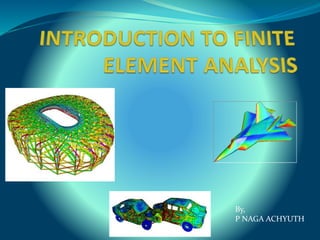
INTRODUCTION TO FINITE ELEMENT ANALYSIS
- 2. What is Finite Element Analysis (FEA)? The Finite Element Method (FEM) is a numerical technique for finding approximate solutions to boundary value problems for partial differential equations. In simple terms, FEM is a method for dividing up a very complicated problem into small elements that can be solved in relation to each other. Useful for problems with complicated geometries, loadings, and material properties where analytical solutions can not be obtained.
- 3. How Does Finite Element Analysis Work? FEA uses a complex system of points called nodes which make a grid called a mesh. This mesh is programmed to contain the material and structural properties which define how the structure will react to certain loading conditions. Nodes are assigned at a certain density throughout the material depending on the anticipated stress levels of a particular area. Regions which will receive large amounts of stress usually have a higher node density than those which experience little or no stress. Points of interest may consist of: fracture point of previously tested material, fillets, corners, complex detail, and high stress areas. The mesh acts like a spider web in that from each node, there extends a mesh element to each of the adjacent nodes. This web of vectors is what carries the material properties to the object, creating many elements.
- 4. Types Of Engineering Analysis : Structural Analysis : Structural Analysis consists of linear and non-linear models. Linear models use simple parameters and assume that the material is not plastically deformed. Non-linear models consist of stressing the material past its elastic capabilities. The stresses in the material then vary with the amount of deformation.
- 5. Vibrational Analysis : It is used to test a material against random vibrations, shock, and impact. Each of these incidences may act on the natural vibrational frequency of the material which, in turn, may cause resonance and subsequent failure Analysis of vibrations in bridges
- 6. Fatigue Analysis : Fatigue analysis helps designers to predict the life of a material or structure by showing the effects of cyclic loading on the specimen. Such analysis can show the areas where crack propagation is most likely to occur. Failure due to fatigue may also show the damage tolerance of the material. Analysis of fatigue in frames of a locomotive
- 7. Heat Transfer Analysis : Heat transfer analysis models the conductivity or thermal fluid dynamics of the material or structure . This may consist of a steady- state or transient transfer. Steady-state transfer refers to constant thermal properties in the material that yield linear heat diffusion. Thermal Analysis of Shell & Tube Heat exchanger
- 8. How can the FEM Help the Design Engineer? The FEM offers many important advantages to the design engineer: • Easily applied to complex, irregular-shaped objects composed of several different materials and having complex boundary conditions. • Applicable to steady-state, time dependent and eigenvalue problems. • Applicable to linear and nonlinear problems. • One method can solve a wide variety of problems, including problems in solid mechanics, fluid mechanics, chemical reactions, electromagnetics, biomechanics, heat transfer and acoustics, to name a few.
- 9. How can the FEM Help the Design Organization? Simulation using the FEM also offers important business advantages to the design organization: • Reduced testing and redesign costs thereby shortening the product development time. • Identify issues in designs before tooling is committed. • Refine components before dependencies to other components prohibit changes. • Optimize performance before prototyping. • Discover design problems before litigation.
- 10. Basic Steps & Phases Involved In FEA: Steps : Discretization Selection of approximation of functions Formation of elemental stiffness matrix Formation of total stiffness matrix Formation of element loading matrix Formation of total loading matrix Formation of overall equilibrium equation Implementation of boundary condition Calculation of unknown nodal displacements Calculation of stresses and strains
- 11. Contd.. Phases: Pre–Processing: Here a finite element mesh is developed to divide the given geometry into subdomains for mathematical analysis and the material properties are applied and also the boundary conditions. Solution: In this phase governing matrix equations are derived and the solution for the primary quantities is generated. Post-Processing: In the last phase, checking of the validity of the solution generated , examination of the values of primary quantities such as displacement and stresses,errors involved is carried out.
- 12. Advantages Of FEA : Can readily handle complex geometry. Can handle complex analysis types like vibration ,heat transfer ,fluids etc. Can handle complex loading: i. Node-based loading (point loads). ii. Element-based loading (pressure, thermal, inertial forces). iii. Time or frequency dependent loading. Can handle complex restraints: Indeterminate structures can be analyzed. Can handle bodies comprised of nonhomogeneous materials: Can handle bodies comprised of non-isotropic materials: Orthotropic & Anisotropic. Special material effects are handled such as temperature dependent properties , plasticity , creep , swelling etc.
- 13. Disadvantages Of FEA : A specific numerical result is obtained for a specific problem. The FEM is applied to an approximation of the mathematical model of a system (the source of so-called inherited errors). Experience and judgment are needed in order to construct a good finite element model. A powerful computer and reliable FEM software are essential. Input and output data may be large and tedious to prepare and interpret. Numerical errors such as the limitation of the number of significant digits, rounding –off occur very often. Fluid elements with boundaries at infinity can be computed and treated by using boundary element method.
- 14. Software Packages for FEA : • ANSYS • NASTRAN • PATRAN • NISA / DISPLAY III • LS DYNA • HYPERMESH • CATIA • Pro-E(CREO) • SOLID WORKS • COSMOS
